It wasn’t the missed calls that worried me — it was the missed connections.
I’ve seen it happen too often: a potential customer calls with genuine interest but never reaches the right person and moves on to a competitor. This is not because your team didn’t care, but because managing calls, follow-ups, and messages across multiple agents quickly turns chaotic.
That’s where having the right inbound call center software paired with a smart contact management system makes all the difference. It helps you organize leads, record every interaction, and set automated follow-up reminders so your team always knows who called, when, and what was discussed. With features like centralized contact storage, call routing, communication history tracking, and built-in reminders, you can maintain consistent customer relationships — even when things get busy.
In this guide, I’ll share the 10 best inbound call center software, based on real experiences and hands-on testing. These tools help you stay connected, deliver faster responses, and make every customer feel heard.
Top 10 Inbound Call Center Software
Below is a curated list of the ten best inbound call center software solutions — each one helping you track leads, manage inbound calls, and stay organised with your team. Take a quick look at their key strengths and starting prices so you can find the right fit for your workflows and budget.
| Tool Name | Best For | Pricing (Starts at) |
|---|---|---|
| BIGContacts | Contact Management & Email Marketing | Free for small teams. Paid plan starts at $9.99/month |
| RingCentral Contact Center | Omnichannel Inbound Routing | Starts at $24.99/user/month |
| Dialpad Support | AI-Driven Voice Workflows | Starts at $15/user/month |
| Talkdesk | IVR/ACD + Deep Analytics | Starts at $85/user/month |
| Five9 | Predictive Routing & Workforce Optimization | Starts at $119/user/month |
| CloudTalk | VoIP Inbound Call Management | Starts at $25/user/month |
| Zendesk Talk / Zendesk Suite | Voice Integration With Ticketing | Custom pricing |
| Freshdesk Contact Center (formerly Freshcaller) | Inbound Call Routing + Simple Setup for SMBs | Starts at $11.3/user/month |
| CallHippo | Virtual Inbound Numbers + Lead Attribution | Starts at $32/user/month |
| NICE CXone | Advanced Analytics | Starts at $135/user/month |
1. BIGContacts – Best for Contact Management & Email Marketing
I used BIGContacts when our referral-based team needed a simple CRM + inbound call handling layer, and it delivered. In my experience, it let me capture leads, track their source, and keep the historical conversations in one place so nothing slipped through. I liked how we could set up who referred the lead, log call notes, schedule follow-ups, and hand off leads to teammates smoothly.
On the inbound-call side, I appreciated that I could tie a “call” or “meeting” to the contact and then prioritise next steps based on that history. So when a lead called in, I already had context and could make the meeting much more relevant.
I found the email-marketing side helpful too: from the same contact record I could see previous conversations, set tasks or meetings, send bulk newsletters, and categorize contacts (referrals, customers, suppliers) so the database stayed organised. Because I used it daily, the UI felt intuitive and the learning curve was low — which made it easier to get the rest of the team on board quickly.
Pros:
- Built-in lead source tracking to help businesses see exactly where their leads originate
- The platform automatically logs emails, meetings, and call notes, ensuring that every interaction is documented and easy to access.
- The email marketing integration allows teams to send campaigns, monitor engagement, and manage follow-ups without using separate tools.
- Collaborative features like shared task management and contact hand-offs make it ideal for teams that need transparency in their sales or service processes
Cons:
- No downloadable or on-premise version
- Dark user interface option not available
Pricing:
Free for small teams. Paid plan starts at $9.99/month.
2. RingCentral Contact Center – Best for Omnichannel Inbound Routing
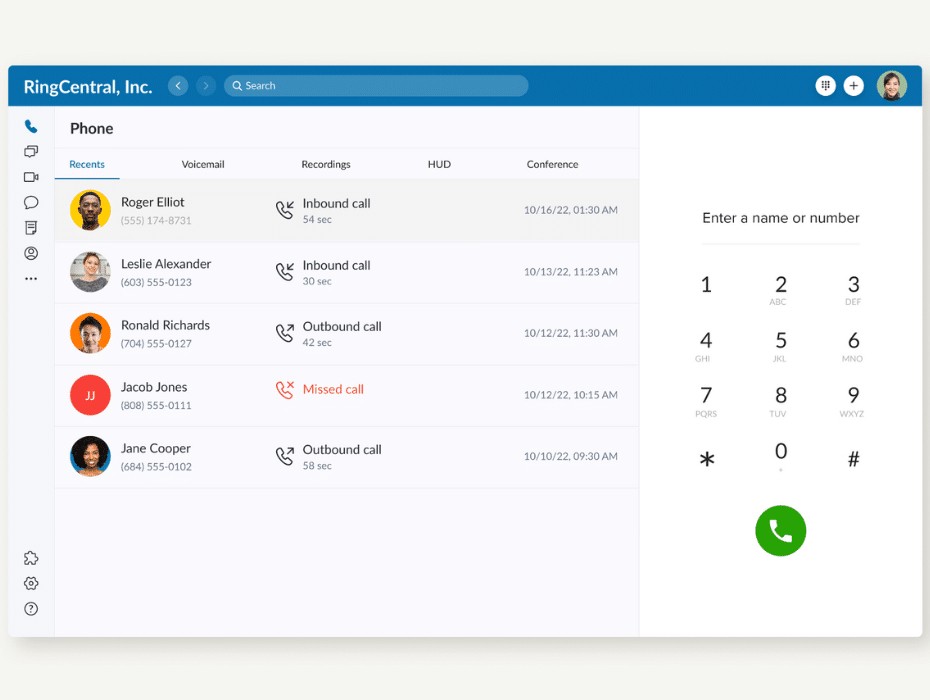
Image source: RingCentral
When I started using RingCentral Contact Center, my goal was to manage customer inquiries from multiple channels — phone, chat, SMS, and even social media — in one place. It delivered exactly that. The system made it easy to route incoming requests to the right person based on skill, department, or customer type. Having everything integrated meant we never missed a message, no matter where it came from.
One thing I really liked was how it allowed us to monitor live activity. I could see which agents were handling calls, how long customers were waiting, and how efficiently the team was performing. The dashboards and analytics helped us identify patterns, such as peak call times or recurring customer concerns, so we could plan staffing better.
It took a bit of time to set up, but once it was configured, everything ran smoothly. The platform felt enterprise-ready, but still manageable for a mid-sized team like ours. It became our go-to system for keeping communication organized and ensuring every inbound request was handled quickly and professionally.
Pros:
- Omnichannel capabilities to allow businesses to handle voice, chat, email, and social messages within a single platform.
- The system’s intelligent routing engine ensures each customer is directed to the most qualified agent, reducing wait times and transfers.
- Advanced real-time analytics to give managers complete visibility into performance metrics
- The platform integrates easily with popular CRMs and business tools, which streamlines contact management and improves overall team productivity.
Cons:
- The initial setup and configuration can be time-consuming, especially for teams without dedicated IT support.
- Pricing can be relatively high for smaller businesses that only require basic inbound call routing or limited channels.
Pricing:
Starts at $24.99/user/month.
3. Dialpad Support – Best for AI-Driven Voice Workflows

Image source: Dialpad
Dialpad Support makes smart use of AI in inbound call handling. The system automatically transcribed calls in real time, provided quick summaries, and even highlighted key action items after every conversation. It made my day-to-day work smoother because I no longer had to manually take notes or worry about missing important details.
The interface was clean and easy to navigate. I could set up call routing based on team availability, track customer sentiment, and review conversation data to spot recurring issues. It helped our small team operate more efficiently and gave us insights into how well each agent was handling interactions.
I also appreciated that the platform worked seamlessly for hybrid and remote teams. We used it across laptops and phones without any noticeable lag, and the cloud-based setup meant I didn’t have to install or maintain any complicated infrastructure.
Pros:
- AI-powered transcription and real-time analysis to help teams capture important details from every call automatically.
- The interface is modern and intuitive, allowing agents to quickly access call histories, performance data, and customer context
- The system includes built-in sentiment analysis, which provides valuable insight into customer mood
- Cloud-native design supports hybrid and remote work, enabling teams to handle inbound calls from virtually anywhere with consistent call quality
Cons:
- Smaller teams or basic users may find the AI features more sophisticated than they need for simple call routing and tracking.
- Some of the advanced analytics and automation capabilities are locked behind higher-tier plans, which could increase overall cost.
Pricing:
Starts at $15/user/month.
4. Talkdesk – Best for IVR/ACD + Deep Analytics

Image source: Talkdesk
The interface of Talkdesk gave me full visibility into call queues, agent status, and customer journeys in real time. The system’s IVR and ACD capabilities were impressive — I could design routing rules based on skill sets, departments, or even customer history without needing technical help.
The analytics dashboard quickly became one of my favorite parts. It presented data on call volume, agent performance, and customer satisfaction in a clear, actionable format. It was easy to spot where bottlenecks were forming or where we needed additional staff during peak hours. This level of insight helped us improve response times and overall service quality.
Although it took some time to get comfortable with all the tools and automation features, once everything was configured, the platform worked beautifully. For teams looking for a system that combines efficiency, intelligence, and depth, Talkdesk offered a very smart solution.
Pros:
- Offers enterprise-level IVR and ACD features, allowing teams to design detailed routing flows that send calls to the right agents every time.
- The analytics and reporting tools are exceptionally thorough, giving deep insight into performance metrics
- The system integrates well with most leading CRMs, allowing inbound call data and customer information to stay perfectly in sync.
- The automation tools help reduce manual tasks, freeing agents to focus more on solving customer issues rather than managing workflow steps.
Cons:
- Because of its extensive capabilities, smaller teams may find Talkdesk more complex than they actually need.
- The setup and configuration process can take time, especially for businesses new to advanced routing or analytics systems.
Pricing:
Starts at $85/user/month.
5. Five9 – Best for Predictive Routing & Workforce Optimization
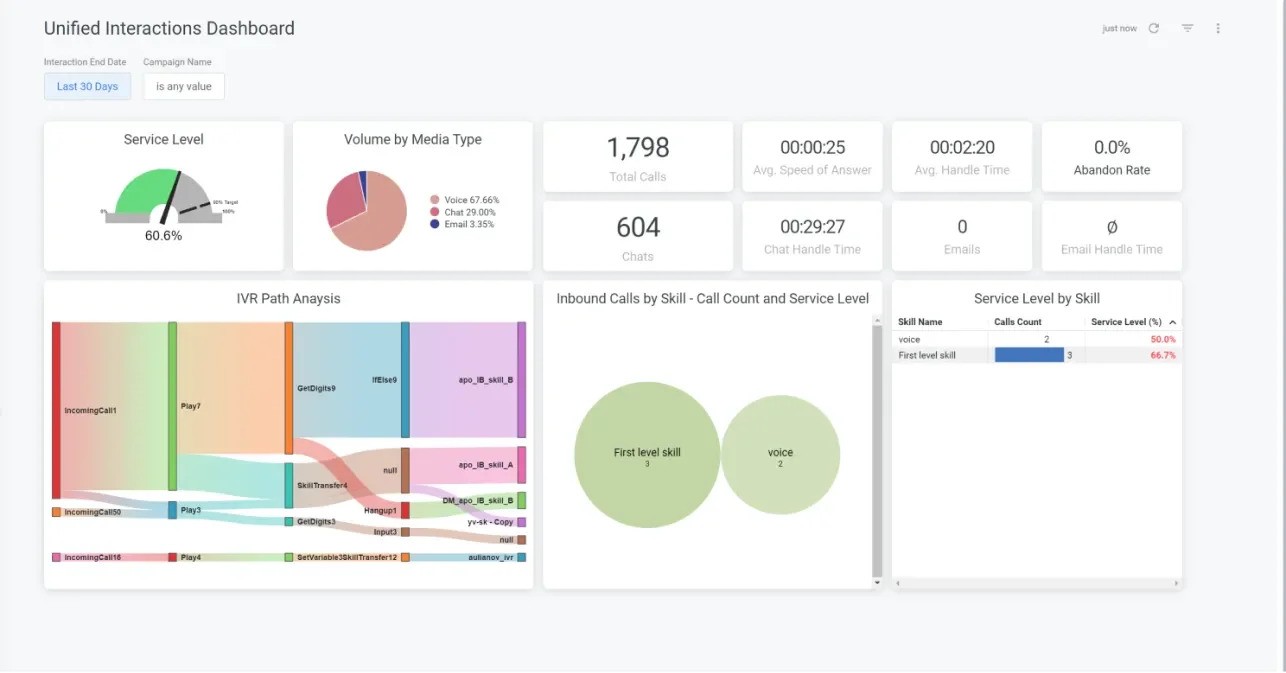
Image source: Five9
When I worked with Five9, it became clear why so many large organizations use it for inbound call management. It handled a heavy volume of calls effortlessly, ensuring that customers were routed to the right agents through its predictive and skills-based routing system. I could monitor call activity in real time and analyze performance without needing to jump between tools or dashboards.
The system’s built-in workforce optimization tools were particularly valuable. They allowed me to forecast call demand, schedule agents efficiently, and maintain a balanced workload across the team. Having both routing and workforce management in one place helped minimize downtime and improved our overall response rate.
Although the platform offered powerful capabilities, it was more than what our smaller team needed. Setting it up required time and attention to detail, but once configured, it delivered consistent reliability and deep insights. It’s an ideal solution for larger operations that rely on speed, precision, and scale.
Pros:
- Exceptional routing features ensure inbound calls reach the right agents using advanced algorithms that minimize wait times and misdirected calls.
- The workforce optimization tools help organizations plan schedules, track adherence, and improve agent utilization
- Its comprehensive reporting capabilities give full visibility into performance metrics such as average handling time, customer satisfaction, and agent productivity.
- The platform integrates seamlessly with major CRMs like Salesforce and Zendesk, enabling a smooth flow of customer data and communication history.
Cons:
- The initial setup and configuration can be complex and time-intensive, particularly for teams without technical support.
- The interface, while powerful, may feel overwhelming for new users who only require basic call management functions.
Pricing:
Starts at $119/user/month.
6. CloudTalk – Best for VoIP Inbound Call Management

Image source: CloudTalk
The onboarding process of CloudTalk was simple — I didn’t need any technical expertise to get things running. Within minutes, our team could make and receive calls, create custom workflows, and track call activity directly inside the dashboard.
The call quality was consistently clear, even when working remotely. I especially liked the call flow designer, which let me create rules for routing calls based on time, department, or customer type. This made it easy to ensure that every caller reached the right person without unnecessary transfers. The CRM integrations worked well, automatically logging calls and syncing customer information across our tools.
Overall, CloudTalk felt like a perfect fit for small to mid-sized teams that value simplicity and flexibility. It offered all the essentials — call recording, tagging, analytics, and performance tracking — without the heavy complexity that comes with enterprise systems.
Pros:
- The call flow designer allows businesses to create custom routing rules, helping customers reach the right department or agent quickly
- Strong VoIP capabilities to ensure high-quality calls even when team members are working remotely or from different locations.
- Built-in CRM integrations automatically log call details, saving time and maintaining an accurate record of customer interactions.
- CloudTalk’s lightweight design makes it ideal for small and medium-sized teams that want professional-grade features without enterprise-level complexity
Cons:
- The reporting and analytics features, while useful, may not be detailed enough for organizations that need advanced performance tracking.
- Some of the more advanced functionalities, like multi-level IVR or deep automation, require higher-tier plans.
Pricing:
Starts at $25/user/month.
7. Zendesk Talk / Zendesk Suite – Best for Voice Integration With Ticketing
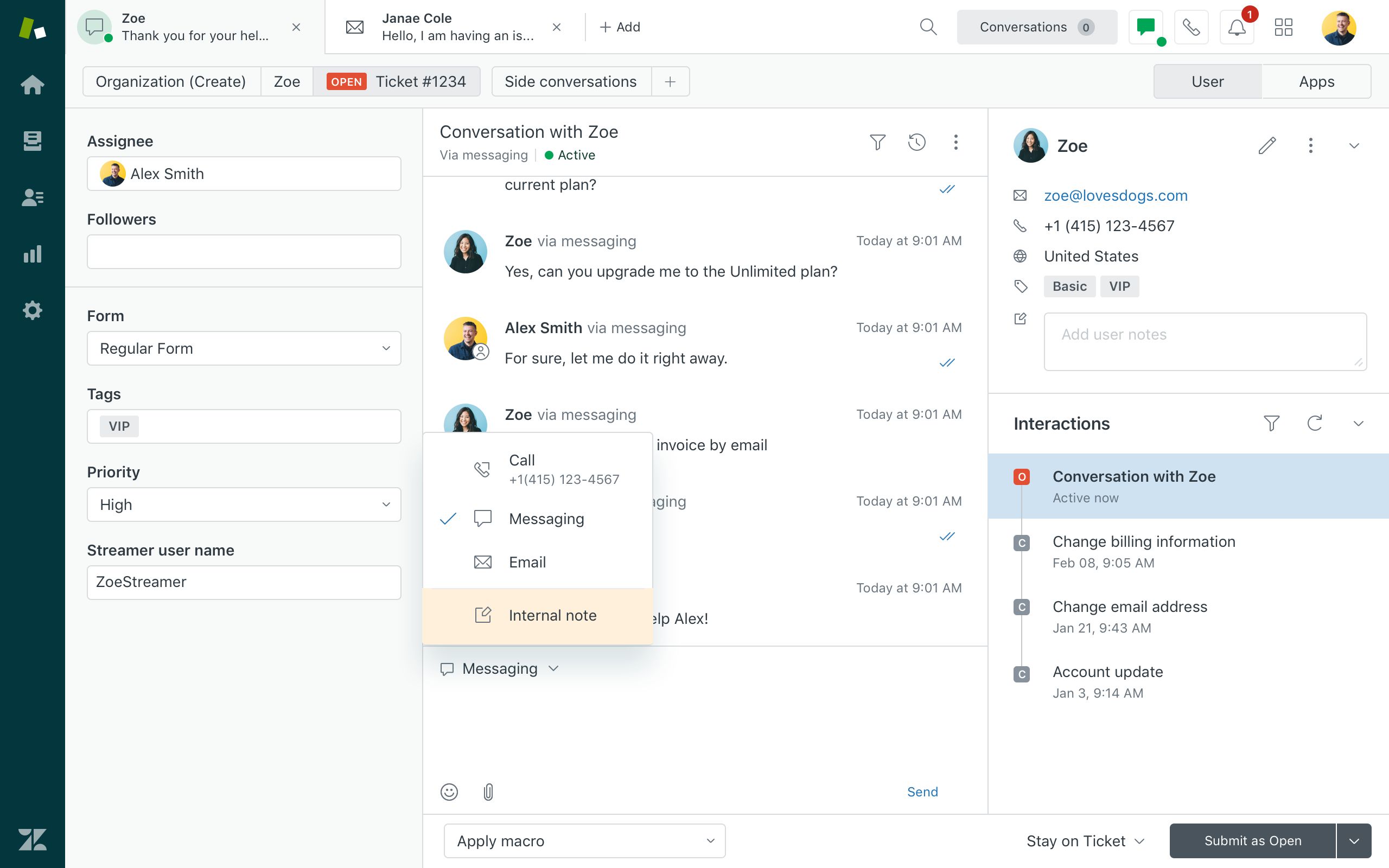
Image source: Getvoip.com
Zendesk smoothly integrated voice communication into our existing customer support workflow. Since we were already using Zendesk for ticketing, having calls show up in the same interface as emails and chats made things incredibly convenient. Every inbound call automatically created a ticket, so nothing slipped through the cracks.
The system gave me a complete view of customer history before I even picked up the phone. I could see previous tickets, notes, and conversations, which made each interaction more personal and efficient. The call recordings and automatic ticket creation also helped with quality control and training new agents.
What I appreciated most was the consistency — every call, email, and chat conversation lived in one place. It reduced back-and-forth between systems and helped our team respond faster and with more context. For support teams focused on delivering great customer experiences, Zendesk Talk made inbound call management feel seamless.
Pros:
- Integrates voice calls directly with Zendesk’s ticketing system, allowing teams to manage all customer interactions in one unified dashboard.
- The system automatically generates tickets from inbound calls, ensuring that every issue is tracked and followed up on systematically.
- Access to customer history and previous tickets provides agents with full context before engaging with the caller.
- Built-in call recording and analytics features help managers monitor quality and identify opportunities for agent training or process improvement.
Cons:
- Zendesk Talk’s advanced features, such as IVR trees and analytics dashboards, often come at an additional cost or require higher-tier plans.
- Smaller teams that do not already use Zendesk may find the platform’s full suite more expensive and complex than necessary.
Pricing:
Custom pricing.
8. Freshdesk Contact Center (formerly Freshcaller) – Best for Inbound Call Routing + Simple Setup for SMBs
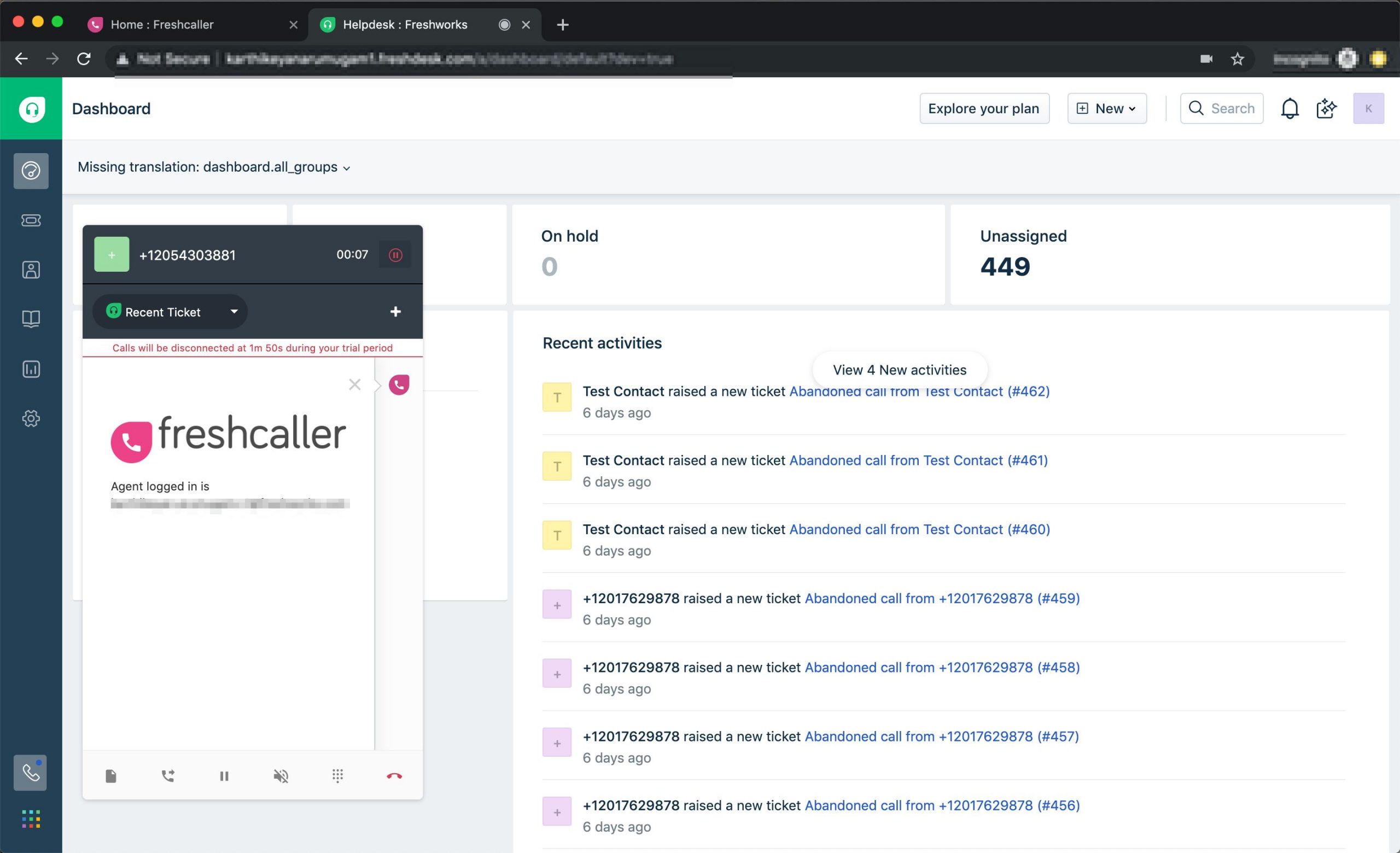
Image source: Freshworks
When I used Freshdesk Contact Center, what struck me first was how quickly the system came together. I was able to spin up inbound call queues, purchase virtual numbers, and start receiving calls in minutes — without dealing with hardware or complex setup. The ease-of-use felt designed for smaller teams who need professional inbound workflows without heavy overhead.
In my experience, its call-routing and IVR tools were flexible but straightforward. I could set business hours, define wait-queue behaviour, and add warm transfers so callers reached the right person. It also recorded call logs and allowed call tagging so that follow-up steps were easier to track.
Because I was managing a small team, what I appreciated most was that the platform didn’t feel overly complicated. It offered enough inbound call-management features (voicemail, recording, queue routing) to make a difference, but still remained accessible.
Pros:
- Provides a fast setup experience, enabling teams to go live with inbound call routing in just minutes without hardware investments.
- It offers a flexible set of routing features — business hours, wait queues, warm transfers — helping clients reach the right agent rather than bouncing around.
- Call-logging, tagging, and contact history capture ensure inbound calls don’t fall through the cracks and follow-ups are tracked.
- As part of the Freshworks ecosystem, it integrates easily with other tools (CRM, ticketing), which helps simplify workflows across sales and support.
Cons:
- While the feature set is strong for its category, it falls short of the advanced routing, workforce optimisation, and analytics found in high-end call-centre platforms.
- For businesses that scale quickly or handle very high inbound volume across multiple channels, the system may require upgrading or layering with other tools.
Pricing:
Starts at $11.3/user/month.
9. CallHippo – Best for Virtual Inbound Numbers + Lead Attribution
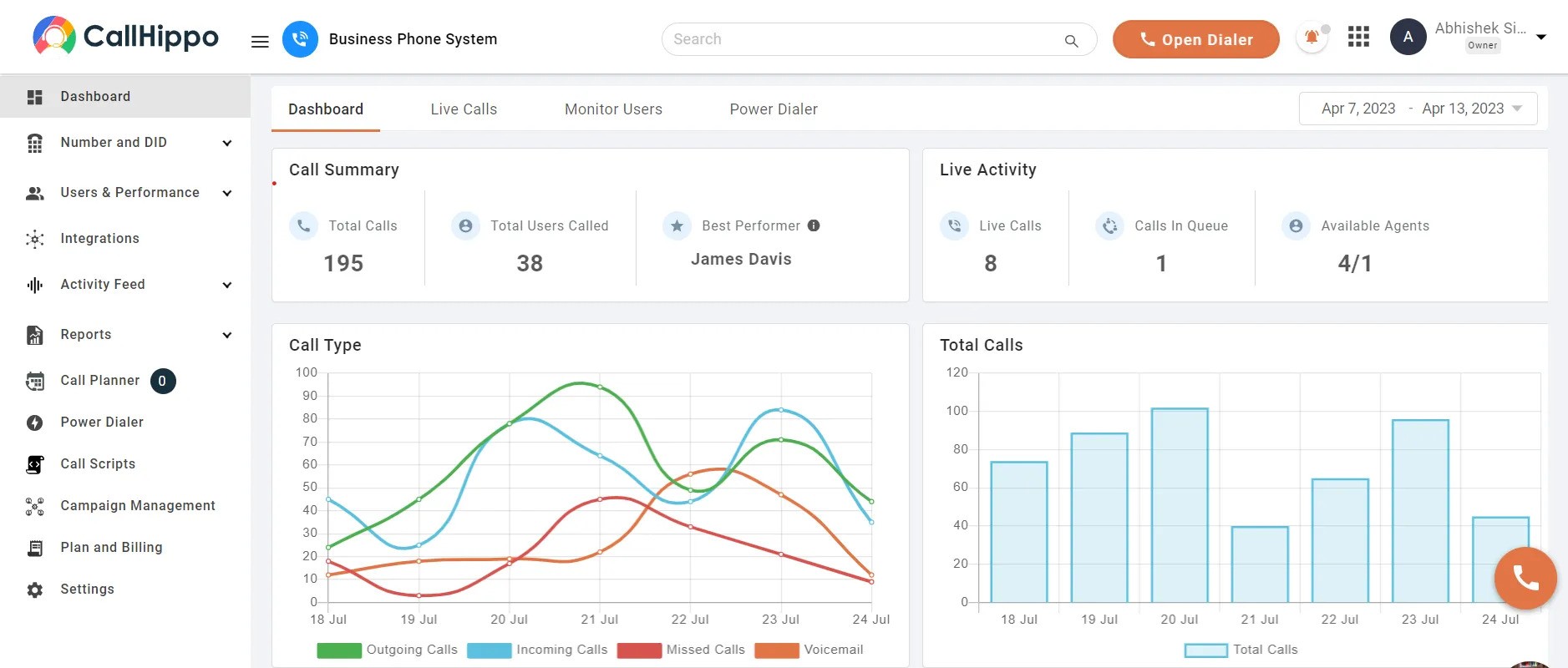
Image source: CallHippo
When I adopted CallHippo for our inbound-call tracking, it made a noticeable difference in how leads were captured and followed up. The platform allowed us to assign virtual phone numbers in multiple countries, tag each lead by source, and seamlessly route calls to the right team member without delay. It meant that when a referral came in, we instantly knew who brought it, how, and who should handle it next.
The interface was refreshingly simple, so even team members who weren’t “techy” picked it up quickly. I appreciated how call logs, recordings, and CRM integrations were accessible from one dashboard — that made follow-ups far easier. Since our business is referral-and-handoff heavy, that level of visibility was exactly what we needed.
Of course, it wasn’t perfect. There were minor glitches, and the advanced features required a bit of extra configuration. Still, for a solution focused on virtual inbound numbers and lead attribution, it delivered strong value. If you’re running a smaller inbound workflow and want clarity on lead source + call history + team hand-off, CallHippo is a viable contender.
Pros:
- Offers virtual local and toll-free numbers in many countries, giving businesses international reach
- The lead-attribution and call-tagging features help teams track which sources or campaigns are driving inbound calls
- Its user-friendly interface and quick onboarding mean teams can start handling inbound calls almost immediately without heavy training.
- Integrations with popular CRMs and contact-management tools.
Cons:
- Some users reported occasional call-quality issues or minor connectivity glitches, particularly under heavy load or in lower-bandwidth settings.
- While the base pricing is attractive, the most powerful features (like advanced analytics or AI routing) tend to sit behind higher-tier plans, which can increase total cost.
Pricing:
Starts at $32/user/month.
10. NICE CXone – Best for Advanced Analytics
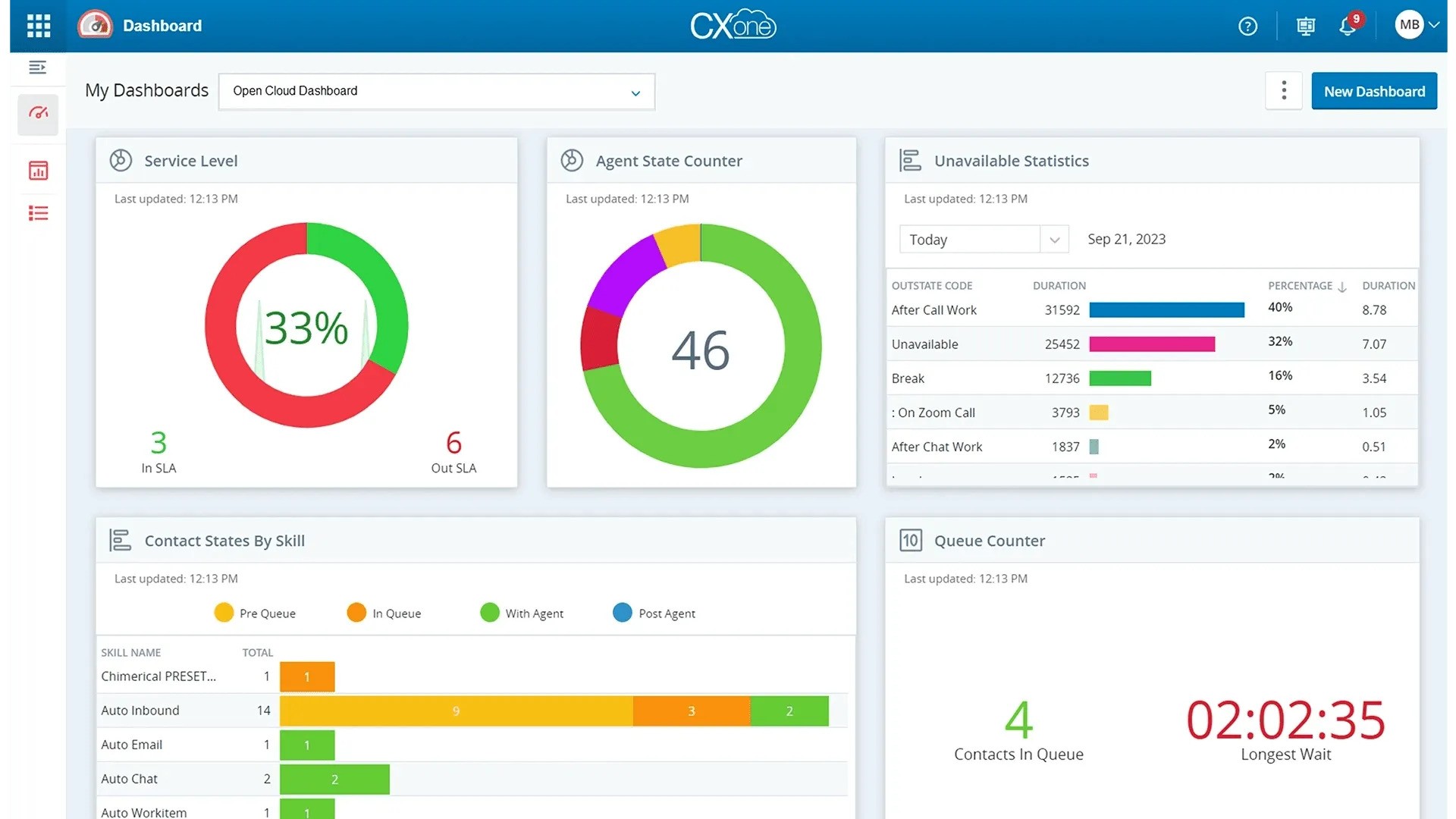
Image source: NICE
I used NICE CXone when our inbound call centre operations scaled rapidly, and I quickly realized its power to handle complex workflows with ease. The platform delivered highly intelligent routing, connecting callers to the best available agent based on skill, availability, and interaction history. It allowed us to unify voice, chat, email, SMS and social channels — so no matter how the customer contacted us, the experience stayed consistent.
What really stood out was the depth of the analytics and AI-powered insights. For example, real-time sentiment analysis flagged negative customer mood, and the workforce-management tools helped forecast staffing needs, track agent adherence, and maximise efficiency.
However, because of its heavyweight feature set, I found that the implementation required careful planning, and the user-interface had a steeper learning curve for team members who were used to simpler systems.
Pros:
- Offers a truly unified omnichannel platform, so voice, chat, email, SMS and social interactions are all managed within one system.
- AI-driven analytics enable companies to extract deep insights from interactions.
- Workforce optimization tools help forecast call volumes, schedule agents, monitor adherence, and improve efficiency.
- Designed for scalability and enterprise-level performance: it supports global deployments, high availability, and integration with major CRMs and business systems.
Cons:
- The advanced features and breadth of capabilities come with a significant cost, making it less practical for small teams or businesses with limited inbound call volumes.
- The user interface and workflow configuration tend to be more complex than lightweight solutions, requiring more training and possibly dedicated admin resources.
Pricing:
Starts at $135/user/month.
My Top 3 Picks for Inbound Call Center Software
Here are my top three choices for inbound call center software — each selected because they deliver strong functionality while being relatively easy to adopt.
1. BIGContacts
BIGContacts is a streamlined CRM designed for you to manage contacts, track inbound calls, and stay on top of follow-ups without juggling multiple systems. I found it particularly useful because all your email conversations, tasks, and lead sources are stored in one place, so nothing falls through the cracks. It also lets you customize fields, automate reminders, and see who is referring leads — which is ideal when you’re handing off qualified contacts.
2. RingCentral Contact Center
RingCentral Contact Center is a full-fledged omnichannel inbound call management solution that supports voice, chat, SMS, and social media from a single platform. It gives you smart routing, real-time analytics, and deep integrations with your CRM. If you have multiple channels of inbound contact and want one place to manage them all, RingCentral is very capable — though for smaller teams, the setup can feel a bit over-engineered.
3. Dialpad Support
Dialpad Support stands out when you’re looking for cloud-native inbound call workflows with AI built in — things like live transcription, sentiment analytics, and voice-routing that adapts to your team’s workload. It works well for remote or hybrid teams and lets you scale up or down quickly. That said, while the feature set is rich, some of the advanced AI capabilities may not be fully utilised if your workflow is simpler.
Key Features to Look for in an Inbound Call Center Management Solution
When you’re choosing an inbound call center solution, it’s not just about answering calls faster — it’s about giving your customers a better experience every time they reach out. Here are some must-have features to look for:
1. Smart Call Routing
You want every call to go to the right person, right away. Look for a system with intelligent call routing (like IVR or skill-based routing) so customers don’t have to repeat themselves or wait endlessly in the wrong queue.
2. Real-Time Analytics and Reporting
You can’t improve what you don’t measure. Good inbound call management software should show you live data — call volumes, response times, and customer satisfaction — so you can spot issues early and make data-driven improvements.
3. Call Recording and Monitoring
Being able to listen to past calls helps you coach your team and understand what’s working (and what’s not). It’s a simple but powerful way to improve service quality and train new agents effectively.
4. Automation and Follow-Ups
The best tools don’t just route calls — they help you set reminders, automate follow-ups, and send quick confirmations. These small touches make a big difference in keeping customers happy and informed.
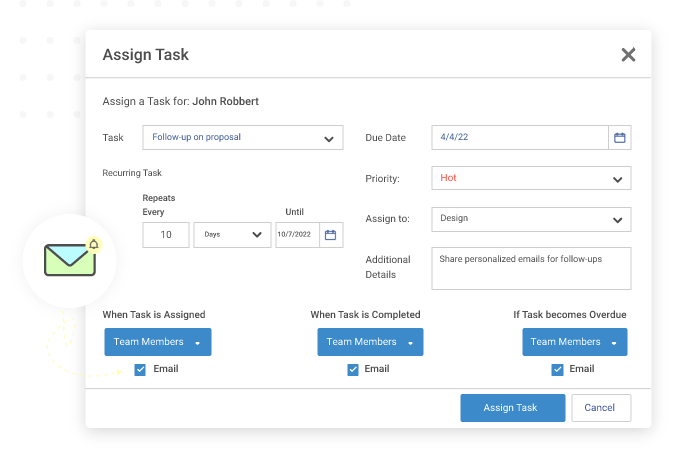
5. Scalability and Ease of Use
Your software should grow with you. Whether you have a team of five or fifty, it should be easy to add users, manage permissions, and get everyone up to speed without hours of training.
Future Trends in Inbound Call Center Software
The software you choose today must not only support inbound routing—it also needs to keep pace with three major shifts: advanced AI, true omnichannel support, and smarter workforce optimization.
1. AI and Automation
You’re probably tired of repetitive tasks eating up your team’s time. The next-gen inbound call management solution will lean into AI and automation to handle simple queries, route calls intelligently, and surface actionable insights.
According to recent research, AI integration is one of the top trends shaping inbound call centers in 2025.
That means you’ll see bots taking care of routine questions, and agents stepping in when things get more complex. As you evaluate software, you’ll want features like AI-driven call routing, sentiment analysis, or agent-assist tools that help your team work smarter—not harder.
2. Omnichannel Support
Today’s customers expect you to meet them where they are: voice calls, chat, SMS, social media, even video. A top inbound call management solution will treat voice as one channel among many, but still give you a unified view of each customer’s journey.
For you, this means choosing software that ties together all inbound communication—so when a prospect contacts you by chat and then calls in later, your team sees the full picture. That continuity boosts satisfaction and makes follow-ups more effective.
3. Workforce Optimization and Smarter Metrics
In the past, tracking inbound calls might have been about answering fast and reducing hold times. Now, you’ll want more nuance: tracking sentiment, agent efficiency, first-call resolution, referral lead-handoffs, and how all of that affects revenue or conversions.
What this means for you: look for software that helps prioritise meetings, schedule agents based on peak loads, and review performance in a way that makes your next move clear. For example, which referral sources produce the highest quality calls? Which agents convert lead-intake calls into scheduled meetings best? Having that insight is going to matter.
Turn Every Call Into a Meaningful Interaction
Choosing the right inbound call center software isn’t just about managing calls — it’s about creating a smoother, more personal experience for every customer who reaches out to you. When your team has the right tools, you can focus more on solving problems and less on juggling systems or tracking missed calls.
With so many platforms available, it’s worth thinking about what matters most to you — whether that’s better call routing, AI-driven insights, or seamless CRM integration. The best solution is the one that makes your day easier, keeps your customers happier, and gives your team more time to focus on meaningful interactions instead of repetitive tasks.
If you’re looking for something that helps you manage contacts, automate follow-ups, and track communication history effortlessly, a tool like BIGContacts CRM is worth exploring. It’s a tool built for growing businesses that want to stay organized without overcomplicating things — and it even offers a free plan to help you get started at your own pace.
Frequently Asked Questions
Is inbound call center software only for large enterprises, or can small-to-mid businesses benefit?
Small and mid-sized businesses absolutely can benefit — many modern inbound call centre platforms are designed to be user-friendly, cost-effective and scalable, making them a good fit for growing teams that need better contact and lead tracking. Even for referral-based workflows (qualifying leads, handing them off, scheduling meetings) you’ll find relevant solutions.
How much does inbound call center software typically cost and what pricing models should I expect?
Pricing varies widely depending on features, number of agents and channels supported. Many start-up friendly plans begin around $10-$30 per user/month for voice-only and basic routing, while full-featured omnichannel systems for larger teams can start at $80-$100+ per user/month or more. When budgeting, look for hidden costs like minutes, virtual numbers, add-on features or international carriers.
How do I choose the best inbound call center software for our specific needs?
Start by defining your key use cases: How many inbound calls do you expect? Do you need multiple channels (chat, SMS, voice)? Do you need CRM/lead source tracking? Next, match those to features (routing, integrations, analytics) and test usability. Also, take advantage of demo or trial versions — this helps you evaluate how the tool handles your real workflows (tracking leads, scheduling meetings, handing off tasks) before committing.
FREE. All Features. FOREVER!
Try our Forever FREE account with all premium features!





